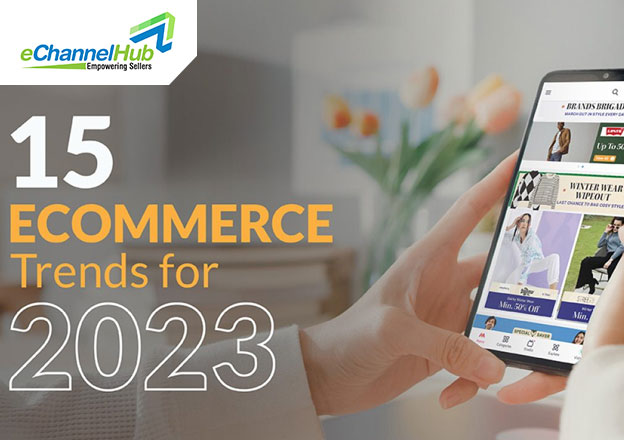15 ECOMMERCE TRENDS THAT YOU NEED TO KNOW IN 2023

Get ready for the future of eCommerce! As we look ahead to 2023, there are some exciting trends on the horizon that you won’t want to miss.
What was popular a few years ago may not be relevant today. As eCommerce continues to evolve in 2023, it’s important to stay on top of the latest trends and work with the top Magento development companies in the USA to ensure your online store is optimized for success. Here are 15 eCommerce trends that you need to know in 2023:
Increased Personalization
Personalization is no longer a nice to have. It’s a must-have. Consumers expect brands to offer a personalized experience and are willing to pay more. A study by Accenture found that 72% of consumers are willing to share their data if it means they’ll get a more personalized experience.
To meet this demand, brands need to invest in personalization tools. This could include using customer data to recommend products, tailoring the user experience, and offering personalized discounts and promotions.
More Social Commerce
Social media is a powerful marketing tool that will only become more important in the coming years. Social commerce is expected to grow from $30 billion in 2020 to $175 billion by 2023.
As social media usage increases, so does the opportunity for brands to sell through these platforms. In addition, more platforms now offer native shopping features, and users are becoming more comfortable making purchases through social media.
To take advantage of this trend, brands need to have a strong social media presence and make it easy for users to purchase products through their platforms.
Augmented Reality
Augmented reality (AR) is another trend that’s on the rise. This technology allows users to superimpose digital images in the real world. This can be used for a number of purposes, including product demonstrations, virtual try-on, and more.
Some brands are already using AR, and it’s expected to become more widespread in the coming years. Gartner predicts that by 2022, 100 million consumers will shop in AR online and in-store.
To get ahead of the competition, brands must start experimenting with AR. This could include creating AR experiences on their website or app or offering AR-enabled products.
Voice Shopping
Voice shopping is another trend that’s on the rise. This is where users purchase products using voice commands, typically through a smart speaker such as Amazon Echo or Google Home.
Voice shopping is convenient and easy to use, which is why it’s becoming increasingly popular. A report from eMarketer found that nearly 30 million people in the US used voice assistants to purchase in 2019. This is expected to grow to 55 million by 2022.
To take advantage of this trend, brands must ensure their products are voice-enabled. This means they can be found and purchased using voice commands.
5G
5G is the next generation of mobile network technology, and it’s expected to impact eCommerce significantly. This is because 5G offers faster speeds and lower latency, essential for real-time applications such as AR and voice shopping.
5G is already being rolled out in some countries, and it’s expected to become more widespread in the coming years. This means brands need to start preparing for the 5G era. This could include investing in 5G-enabled devices and applications and optimizing their website for 5G.
Blockchain
Blockchain is a distributed database that allows for secure, transparent, and tamper-proof transactions. This makes it ideal for a number of applications, including eCommerce.
Some brands are already using blockchain, and it’s expected to become more widespread in the coming years. This is because blockchain can help to improve the security and efficiency of e-commerce transactions.
To take advantage of this trend, brands need to start experimenting with blockchain. This could include using blockchain to secure customer data, process payments, and track shipments.
IoT
The Internet of Things (IoT) is a network of connected devices that can collect and share data. This data can be used to automate processes and make better decisions.
Some brands are already using IoT, and it’s expected to become more widespread in the coming years. This is because IoT can help to improve the efficiency of eCommerce operations. For example, IoT-enabled devices can be used to track inventory levels and automatically reorder products when they run low.
To take advantage of this trend, brands need to start experimenting with IoT. This could include investing in IoT-enabled devices and applications and integrating IoT into their existing systems.
Predictive Analytics
Predictive analytics is an artificial intelligence that uses data to predict future events. This can be used to improve decision-making and automate processes.
Some brands are already using predictive analytics, and it’s expected to become more widespread in the coming years. This is because predictive analytics can help improve e-commerce decisions’ accuracy. For example, predictive analytics can recommend products to customers or forecast demand for new products.
To take advantage of this trend, brands need to start experimenting with predictive analytics. This could include using predictive analytics to recommend products, automate processes, or personalize the user experience.
Customer Experience
Customer experience is becoming increasingly important and will only become more important in the coming years. Customers are becoming more demanding and expect brands to offer a seamless, personalized experience.
To meet this demand, brands need to invest in customer experience tools. This could include using customer data to personalize the user experience, offering live chat support, and providing self-service tools.
Data Management
Data is valuable and will only become more valuable in the coming years. This is because data can be used to improve decision-making, personalize the user experience, and automate processes.
To take advantage of this trend, brands need to invest in data management tools. This could include using customer data to segment customers or using data to personalize the user experience.
Mobile commerce
Mobile commerce has been steadily growing in popularity over the past few years and it’s expected to take center stage in 2023. More and more consumers are using their mobile devices to shop online, and retailers will need to make sure their websites and apps are optimized for mobile use. Mobile checkout processes will also become more streamlined and user-friendly as retailers look to make it easier for customers to make purchases on the go.
Subscription-based models
Subscription-based models have been around for a while and they’re expected to expand into new areas. In addition to traditional subscription services like meal kits and beauty boxes, we can expect more retailers to offer subscriptions for everyday products like groceries and household items. These models appeal to customers because they provide convenience and cost savings, and they can also provide a reliable source of revenue for retailers.
Omnichannel commerce
Omnichannel commerce has been a buzzword in the eCommerce industry for several years now, but in 2023, it will continue to grow in importance. Retailers will need to ensure that their online and offline channels are seamlessly integrated, allowing customers to shop in whichever way is most convenient for them. This might mean offering in-store pickup for online orders or allowing customers to return online purchases in-store.
Chatbots and virtual assistants
Chatbots and virtual assistants are becoming more sophisticated, and at present, we can expect to see them used more frequently in eCommerce. These tools can help customers with everything from finding products to making purchases, and they can also provide personalized recommendations based on a customer’s browsing and purchase history. As chatbots and virtual assistants become more intelligent, they will become an increasingly important part of the eCommerce customer experience.
Headless commerce architecture
Headless commerce architecture is a relatively new concept in eCommerce, but in 2023, it’s expected to become more prevalent. With headless commerce, the front-end presentation layer of a website is decoupled from the back-end commerce engine, allowing retailers to create highly customized and flexible customer experiences. This approach can also make it easier to integrate new technologies and channels, which is important as eCommerce continues to evolve at a rapid pace.
Conclusion
Hire an ecommerce development agency to establish your business and enjoy the perks like most companies do. As you can see, there are a number of eCommerce trends that you need to know in 2023. ECommerce is a constantly evolving industry, and staying up-to-date with the latest trends is essential for retailers who want to stay competitive. By keeping these trends in mind, retailers can create more engaging and personalized customer experiences, increasing sales and customer loyalty.
Author Bio

Ronak Meghani is a serial entrepreneur & eCommerce Consultant who has worked with small-medium-large companies. He is a co-founder of Magneto IT Solutions and has been closely working with eCommerce ventures since 2010. He has helped 200-plus international brands for building/improving their online ventures in the area of UI/UX, development, launching, revenue enhancement, marketing strategy, magento development, eCommerce support and much more, and 90% ventures are generating very good revenue. He’s enthusiastic about start-ups, entrepreneurship, sports, home decor ecommerce, automotive ecommerce, gems & jewellery ecommerce, electronics ecommerce.
Write For Us
Gain multichannel inventory visibility and control with eChannelHub
Learn more about eChannelHub with a free demo, tailored for your unique retail business.
Request A DemoRequest a Demo
Gain multichannel inventory visibility and control with eChannelHub
Learn more about eChannelHub with a free demo, tailored for your unique online business




